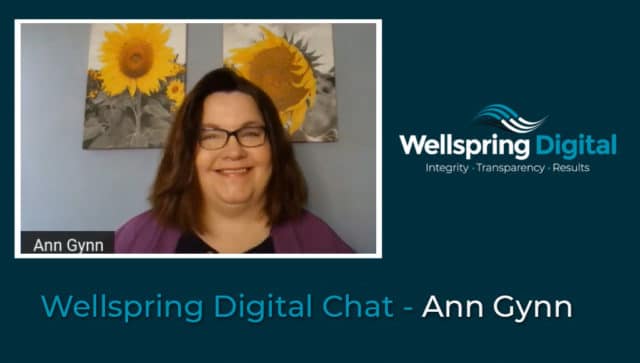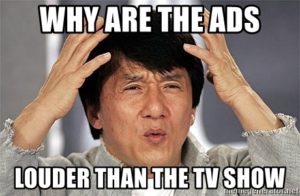Ann Gynn is one of my content people, meaning we both live, love, and preach the importance of great content marketing. It’s a fellowship of sorts. Yes, we’re weird. I am very excited to geek out on content with Ann.
Whenever I’m reading a really good post on Content Marketing Institute, there’s a good chance that Ann wrote it (or at least edited it).
Ann shares so many great tips and advice in this, you don’t want to skip this one!
In this episode, we discuss…
- Creating your own stock photography
- Stock content marketing?
- AI-generated content
- Measuring content against business goals
- The future of content marketing
Let’s do this…
Digital Transcription (Edited for Readability)
Introductions
Jon-Mikel Bailey: Hi, everyone. How are you? That’s great. Glad to hear it. I am Jon-Mikel Bailey and welcome to the Wellspring Digital Chat, where we interview marketing experts. There’s some shadiness involved, some backroom dealings, and there may be some Russian mafia involved, but it doesn’t matter.
All that matters is that we get some really great marketers to agree to come on this show. And we’re grateful to them for doing that. Anyway, I obviously have some mental problems.
Ann Gynn is one of my content people meaning we both live, love, and preach the importance of great content. It’s a fellowship of sorts, I believe, a club, like the Mickey Mouse Club, but smarter. Yes, and we are weird. I am the weirdest probably. But anyway, I’m very excited to geek out with Ann about content.
So Ann, welcome, please take a moment to introduce yourself to these good people.
Ann Gynn: Yeah, so I’m Ann Gynn, and the funny thing, I always tell people, my parents probably thought I wasn’t going to be a great speller. Because my first and last name, only has seven letters, and four of them are N’s. So my mother does not like to hear it. So if you’re watching, I’m sorry, mom. But yeah, that’s where it goes from it. And yet, I built a career out of writing and all things content from that. So it’s kind of funny how I’ve entered into this world of multiple letters.
Jon-Mikel Bailey: You took that challenge, and you ran with it.
Ann Gynn: I did. I did. I always like a good challenge from that. And so that’s where I took, you know, into journalism, and then took my career and been on my own, company called G Force Communication. But where I work and where we talk and where you and I have connected of all things content marketing, from that of working with the Content Marketing Institute, I do some coaching and training and content. And so I keep keep the words going.
Jon-Mikel Bailey: We got to keep the words going, somebody’s got to keep the words going. And we’re gonna definitely going to get into that. I mean, whenever I’m reading really good content on the Content Marketing Institute website, there’s a good chance that an has either written it or edited it, edited it. So thank you for that. So I’m excited to have you and I’m really looking to get waist deep in in some content marketing, so put your waders on. Ann are you ready?
Ann Gynn: I am ready. I think. I don’t know. We’ll try.
Jon-Mikel Bailey: We’ll try you’ll be fine. I’ll be good. So let’s start.
Creating Your Own Stock Photography
Jon-Mikel Bailey: Let’s talk about stock photography. Everyone says they hate it. And yet, it is still widely used. In a recent Content Marketing Institute post you tell marketers to create their own stock photography. I love this idea. And I wonder, can you talk about what you mean here and maybe talk about any potential roadblocks they should look out for when creating their own stock photography?
Ann Gynn: Yeah. So it’s one of those things and it’s interesting, right, we start off with photography, we’re talking about words, but content is more than just words, but I’m a word person. So I will never say just words to get into the visual aspect. When you’re trying to pick a photo, or whatever how many computers and you know, I work in a marketing field so there’s not a lot of dynamic factory photos and all that kind of stuff.
So we end up using stock photos. There are a ton of great resources and yet we probably see the same dozen repeatedly used because let’s think about it. They pop up at the top of the search for whatever you’re looking at – a person with a computer open screen or something like that. So as a user, that’s what prompted me to write the article is frustration in seeing it.
What I’m suggesting is most companies are doing some kind of photoshoot at some time. Or they could hire a photographer for not a heavy investment to come into their office when people are there and shoot standard photos. So that person at the computer, why not make it one of your employees?
Make it one of your employees sitting, somebody picking up a phone, or texting. I went old-fashioned. Remember offices when people picked up phones. So that kind. Another thing is to create a shoot list, and then bring in a photographer if you’re doing a case study. Capital One does this, and I just thought this morning of Antoinette Lee’s Cheese Shop.
And they have a commercial of this couple, and it’s for their small business campaign. But I see that couple in other imagery where they don’t identify them as a case study. They’re small business people. And so they used the art they’ve taken from that commercial shoot, or from a case study profile, whatever you’re doing, and they’re using that for other things. So that’s kind of what I’m talking about. Look, it’s not that hard to start exploring outside of stock.
Jon-Mikel Bailey: Yeah, it makes a big difference too. Especially if, you know, if you’re working with that company, and you say, oh, you know, there’s Ted or there’s Lisa, or whatever.
Ann Gynn: Yeah, added benefits.
Jon-Mikel Bailey: Maybe they should be a little bit careful about how nice the photos look. So they don’t look like I’m totally kidding.
Ann Gynn: No, I think it’s a great point, stock photo, and you’ve got diversity and inclusive representation in the stock photo. And I do think that diversity inclusion, some of my content, and I found a stock photo that helpfully illustrates it. However, everybody’s perfectly polished. It looks like no one ever worked from home in their life. They’re all ready for the biggest meeting of their lives. Well, that’s actually outdated.
Jon-Mikel Bailey: Yeah. Yeah, absolutely. Yeah. We’re all just winging it now. So exactly.
Stock Content Marketing?
Jon-Mikel Bailey: So do you ever get the sense that some companies are using stock content marketing, meaning that they are creating so much of the same cliche content that is already out there? I mean, do you think companies are getting better at creating real useful and impactful content?
Ann Gynn: I think the smart companies are getting better at using real content from it. I think you’re right. And part of what I look at that stock content is the idea that somebody says we should be doing this. We should be doing this social media channel, we should have a blog, we should do this. Without a real strategy behind it.
Jon-Mikel Bailey: With no why?
Ann Gynn: We should and then it becomes factory-like, right? We need to produce this widget, we’re not measuring it, it doesn’t matter. We just need to get it out. So somebody inside our company sees that we’re doing it and we never think about the audience. In fact, we’re writing for our internal executive who said we should do this.
And the other part of it is, and this is, fortunately, this is improving. But it’s an SEO game. So people think for search engines of the days, and I remember I was in a meeting with somebody who was promising, like, we’ll just start all these microsites. And we’ll just put all these keywords in there and sentences. And I was cringing, and this was probably 15 years ago.
And they were that’s what they were selling was really keyword stuffing. No, that’s not even 15 years ago, it wasn’t a smart move. But today, it’s a detrimental move. It’s absolutely just a bad move. It’s not going to produce results, it’s going to have negative effects. And so companies are getting smarter about that kind of thing of providing content that people really want or will need, probably because we talk about content as people want.
Most of the time, it’s content people need. We’re not all searching for great content out there.
Impactful Content – Doing More with Less
Jon-Mikel Bailey: Well, you had a post recently on the CMI blog, I believe that was about you know, the idea of doing more with less. Where you’re focusing on creating more impactful content and less churn? Right. Is that? Is that kind of a good summation of that post?
Ann Gynn: Yeah, I think there’s a couple of reasons for that. It’s going deep or going substantive, I should say deep doesn’t mean long. It just means substantive and valuable. And then kind of almost repurposing that if you have to be on every platform. Because I do know that sometimes you have to do things that aren’t the smartest move. Because you have because people are involved, right?
There’s an executive, you’ve got to have a presence. But how can you do that in a way that you still get substantive content that maybe you don’t publish as frequently? Maybe you’re repackaging but yeah, no, I think you’ve got it exactly right.
AI-Generated Content
Jon-Mikel Bailey: I think it’s important and unfortunately, the machines are against us, because speaking of bad content, I want to get your thoughts on AI-generated content marketing. I know Google has stated that AI-generated content is technically against their guidelines, but people are still doing it. So do you think AI can be used effectively for content marketing or is it just another dirty shortcut that’s unfortunate, but not going away?
Ann Gynn: I think it sounds attractive, and I think there are uses for it. It is interesting because Google was just within the past couple of weeks that they came out saying, we consider that spam content. My thing is right, if you detect it, right, exactly, the better it gets, the less detectable it is. And we all have searched for something at one point.
I was watching a TV show the other day. And I wondered how old one of the people on the TV, the actor was. So I did the Google search, and then I come up with this, you know, obviously, AI-generated bio, enjoy this. And you’re like, what? It was weird. Anyway, so. So that kind of content is obvious.
But when you have places and this is a common example, so forgive me, for those of you who’ve already heard it, when you have the Washington Post, using AI-generated content, and they do it. And this is from my small town, newspaper background, they do it for election results, because they have a huge area, so they can feed the election results and get basic content out.
The Importance of Editing Your Content Marketing
Ann Gynn: So for those things right now, I think it works. Is it a shortcut, that people will say, Oh, we don’t need to hire writers? We don’t need to have creators on the team. I think that’s a long way off, if ever, but certainly, probably in all our lifetimes, it’s not going to happen to the detriment of all content is AI-generated? Because when you get it, it’s not it’s a dirty shortcut. But it’s not a shortcut, because you actually have to edit.
Jon-Mikel Bailey: That’s, yeah, well, that’s the problem is I think a lot of companies are just going with the AI content as is. And that’s where you make the biggest mistake. That’s what it looks like. I don’t know if a three-year-old wrote it, a three-year-old computer wrote it.
Ann Gynn: Worse than homemade, right. There are the crafty odds homespun, and then there’s the oh my gosh, do they even know what they’re talking about? And that’s actually, as you point out, it’s riskier to do that than to do nothing.
Jon-Mikel Bailey: I mean, I think it seems a general rule of thumb, and I’m speaking to an editor here that, you know, all content should be edited. I am not a fan of just, you know, writing it and posting it. I know, some people are big on that. I don’t know if you agree or not.
Ann Gynn: I do. I have to admit, I’ve been there on both sides of it. But ya know, I love a good editor. When I’m writing. I love a good editor who kind of pokes and prods most of the time, right? We all get the feedback like, no, this doesn’t make sense.
Jon-Mikel Bailey: You’re not getting where I’m, it’s the feel that I’m…
Ann Gynn: Right. So I say that with knowing that. But that editing thing you can, you can tell a difference in that usually, from that, if you’ve seen the raw copy from that, and it’s really two pairs of eyes to I know, and I’m guilty of this. When I write I know exactly what I’m saying and why. But to have somebody read it, they go, they missed the point that I was trying to make. Well, that’s helpful to me, because I’m never going to catch it because I always know what I was talking about.
Jon-Mikel Bailey: Well, plus, you get so married to that piece of content, because you’ve worked on it so much, that you miss the stupid little things like you know, misspellings, or maybe a word that is not misspelled, but it’s the wrong word.
Measuring Content Against Business Goals
Jon-Mikel Bailey: You also have an article in CMI warning against using PR metrics to show the value of content marketing. So I was talking to Janet Driscoll Miller about the importance of measuring your marketing against actual business goals.
So does your marketing improve the bottom line is sort of, you know, the point she’s constantly trying to make? And I wonder, do you think marketers are still obsessed with these vanity metrics? Are we ever going to get past market marketing as a, you know, popularity contest?
Ann Gynn: I think it’s a really good question. Because here’s the thing, I think marketers are scared. I hear so many, and this drives me crazy, saying I get into marketing, I get into creating content, so I didn’t have to do numbers. And to do some of the best numbers come from stories, you know, store, some of the best stories are created through numbers.
So I think you’re in a field of people who try to avoid the business side, the finances the all that cut. That’s not why they went into marketing. But those days are leaving us quickly. And for older people who went into marketing where you couldn’t measure everything, right, you sent a direct mail piece out. And it was about how many returned it or mentioned that when they went into a store?
To now where you can follow your customer from the moment they touch something on your digital presence and continue to follow them from it. That’s a different world. And so that’s where I think with marketers now that we’re measuring stuff now that we can measure and more importantly, now that executives know marketing can be measured…
You’re having an expectation on the bottom line that returns on investment and, and there’s a whole conversation to be had around that. But I think to survive, not just to survive, but to lead the conversation. So it isn’t like I wrote this blog, it didn’t lead to any sales. Blogs don’t work. Which is kind of where a lot of people get into content marketing for people who don’t understand it.
Well, no, the blog was never supposed to lead to a direct sale, that was not the purpose. If it did, great. But that would be the anomaly from it. And that’s where marketers today should be taking the lead in identifying the metrics, and the process that is involved to get to that bottom line from it to help educate the C suite. Because we know that the C suite or whoever’s in charge is going to want to know, you’re spending this much how much does that give me in return?
Jon-Mikel Bailey: Yeah, I mean, it and but I think you also have to establish a fine line between everything being data-driven and bottom line-driven and you still need to, you know, in my opinion, connect with the reader or the, or the viewer or watch or whatever you want to call it in some meaningful way. And so sometimes, you know, maybe that gets back into the whole AI argument. But, I mean, it seems like the churn it’s like this, this balance of churn versus keywords versus bottom line versus good content, or, you know, so.
Ann Gynn: And that’s what I’m saying. It’s a great opportunity for the marketer to shape the story, an internal story of what this is supposed to do. From it, you know, I had, talking about PR and that’s why I wrote the piece, so I’ve had done PR work and had PR clients who were so excited to get, we would issue something on the wire, and they’d have this look, people in Alaska read it and this kind of pick up placement.
And they would be all excited at these reports. And I’m like, I didn’t tell them because they were excited, and they’re paying me, but it didn’t, who cares if somebody in Alaska read that you’re doing this event in your community next week? It’s not going to help you. But they were flattered. And I think that’s what you’re talking about impression numbers and vanity metrics are flattering. And “people like me,” I call those people like me numbers. We all like to be liked.
Jon-Mikel Bailey: When when we do a press release at Wellspring for some reason. This I can’t forget the news outlet. There’s this online magazine in Buffalo that always runs the story. And my wife’s from Buffalo is supposed to be like, Honey, look. It’s completely meaningless. But I don’t know. She likes it. You know, you never know.
Go Bills! Sorry. Anyway, so…
Ann Gynn: That’s OK, I’m supportive of the bills.
Jon-Mikel Bailey: Are you? That’s good. I like that. I like that. Well, you’ve just gone up a notch in my family. So I’m, you know, I’m married into it. I’m forced to be a Bills fan. So but you know, they’re fun. I’ll take it.
The Future of Content Marketing
Jon-Mikel Bailey: So, you’ve been working with the Content Marketing Institute for some time now. And I remember. God, this was at least 10 years ago, probably more, I was talking to a colleague. And I mentioned the term content marketing, and they thought that it was something that I just made up. They were like, I think he said something like, that sounds like multilevel marketing or something.
He thought it was like some kind of new scam or something. And I assured him to the contrary, and I told him, Hey, there’s even an institute for content marketing. He was like, Oh, okay. You know, kind of as a sign of its legitimacy.
So, you know, look how far we’ve come. Now, it’s like, you know, you can’t talk about marketing without content marketing. But I’m curious if you could maybe throw on your crazy hat and look in your crystal ball and tell me what you think, is the future of content marketing?
Ann Gynn: Yeah, it’s interesting, right, going back even 10 years from that, and I still, for some family members, they like still don’t get it, of how I’ve explained it. And they’re like, anyways, it’s just been an interesting conversation from it.
But whatever the phrase is, whatever the terminology, the idea of using content to connect and build an audience that becomes your customer base is only going to amplify because we have so many different channels to reach people. But more importantly, because people are choosing resources to learn, to know, to be entertained.
They have so many more choices out there in what they’re doing. And so, delivering content that people like, you know, even 10 years ago, we wouldn’t have said it was a big deal to get a show made for broadcast television, or even for cable television for somebody who’s those creators. And now, people are on YouTube watching home homemade videos, and they could spend hours doing it, because it entertains them, right, they’re getting what they want.
And so that’s where I think, from a marketing standpoint, of using content for good not just for selling people these days are not and the research shows the younger generation specifically, are not used to when a commercial comes up. I was brought up in an era where yes, the commercial comes on, that’s when you go to the kitchen or you take your break. And everything’s natural breaks and television.
But now, it’s not like that. So that disruptive advertising, those disruptions to their experience, they’re not going to be responding to, in fact, they’re going to be repulsed by it. Repulsive is a strong word but repelled I think, from it. I’m gonna look for those experiences. And nope. And few of them are judging and evaluating where does this come from?
To do that, to go, oh, well, this is made by the company ABC. So they’re just trying to get me to buy Company ABC products if it’s good content. If it’s a B2B audience, it teaches me something that helps advance my skills. I’m going to be appreciative of the content and not be like, Oh, they’re just trying to sell me something if it’s well done.
Jon-Mikel Bailey: Right, right. I think two things there. One is Gen Z and Gen Alpha scare the crap out of me. They are, wow, my daughter’s 14. And I watch her just absorb media, and it’s insanity. That makes my head hurt. But anyway, sorry, I’m just trying to make myself look as old as possible.
Ann Gynn: That’s okay. I’m farther.
Jon-Mikel Bailey: But I think it speaks to the point that, I read a book. Oh, man, I forget the author’s name (Sarah Weise) I actually interviewed her on here. I should anyway, it was about marketing to Gen Z. And it was about the idea that, while seemingly it may look like they’re just, you know, scrolling, scrolling, scrolling, when they hook onto something, they do a deep dive. And if you’re just shallow with your content, I think that’s to the detriment, and you may lose potential customers that way. Do you agree?
Ann Gynn: Yeah, well, and you have the chance, once they’ve grabbed onto a piece of content, you can help direct them to the rest of your related content, you can make it easy for them to do that. And I look at YouTube serving enough recommended videos and stuff like that. When if you have all the videos, for example, then they’re gonna keep putting up your videos, but the minute you they run out of your stuff, they’re gonna go to somebody else, somebody else YouTube’s recommending somebody else.
And, yeah, it’s a great opportunity to keep going down that path. And that’s again, right. That’s that focus that’s going deep from it and not trying to do keyword stuffing of the old days, and the surface level contents just so you have content up there. It’s about building a content relationship with a consumer from that. And that’s pretty powerful.
Jon-Mikel Bailey: I like that idea of building a content relationship with the consumer. I think that’s the absolute best way I’ve heard it summed up, and I’m gonna steal that and use it ad nauseam. And I may or may not give you full credit.
Ann Gynn: I’m good. Let’s just spread the word. I don’t care if you credit me, preach this.
Jon-Mikel Bailey: So I think we can both agree that content marketing is not going anywhere. It’s going to continue its rise and important rise up anyway. But the focus needs to be on the quality of the content and connecting with the reader the consumer.
Ann Gynn: Yeah, yeah, keeping top of mind, John Deere did in the 1800s. This isn’t anything new. It’s a maybe a new phrase. But the opportunities to distribute content to people are far different than what John Deere had in those days.
Jon-Mikel Bailey: Absolutely. Yeah. I mean that that example is almost overused, but I think it’s still totally necessary for people to understand that this is not a new concept. The only thing that is different is the technology surrounding it.
Ann Gynn: So yep, it’s work.
Jon-Mikel Bailey: Well, and thank you so much for coming on here and geeking out with me on some content. There’s a lot of really great stuff in here. And so I really appreciate it.
Ann Gynn: Well, I appreciate the chance to talk all things content. You made it easy. It’s always fun. See you Thanks, Jon.




